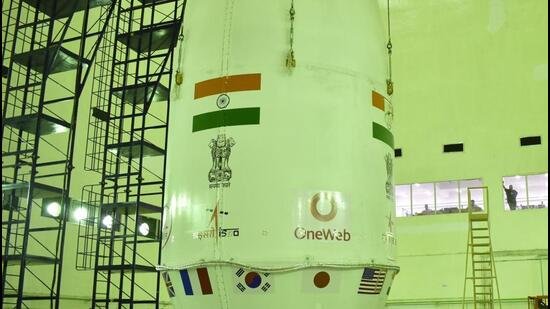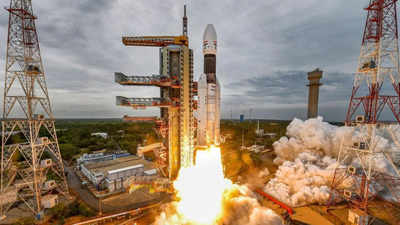Abdus Salem killed
New Member
- Joined
- Mar 10, 2021
- Messages
- 4,103
- Likes
- 15,761
Money comes first'always we need money and techThey have postponed Chandrayaan-3 in favour of OneWeb launch. Haven't they?
Money comes first'always we need money and techThey have postponed Chandrayaan-3 in favour of OneWeb launch. Haven't they?
Yes well.Money comes first'always we need money and tech

New Delhi: After the successful launch of its first commercial mission carrying 36 communication satellites of a private firm, the Indian Space Research Organisation (Isro) is working to add to the weightlifting capacity of its heaviest rocket — Launch Vehicle Mark-3 — for its second launch scheduled early next year, officials of the science ministry said on Tuesday.
The space agency is expected to complete the qualifying tests for the semi-cryogenic stage of the LVM-3 rocket in a couple of months, they said.
“We are hopeful that by February or March next year, we will be able to launch the second batch of 36 satellites of OneWeb. All preparations for it are being done,” a ministry official said, seeking anonymity.
Also read: ISRO to develop reusable rockets, aims to set up space station by 2035: ReportAt 12.07am on October 23, Isro successfully launched 36 communication satellites of OneWeb from the Satish Dhawan Space Centre in Sriharikota, marking its entry into the global commercial launch service market.
OneWeb is a private satellite communications company, which has India’s Bharti Enterprises as a major investor. NewSpace India, a state-owned enterprise under the department of space, had earlier signed two launch service contracts with the London-headquartered Network Access Associated Limited that runs OneWeb to launch a total of 72 low earth orbit satellites on board the LVM3 rocket.
On Friday, the space agency successfully conducted the flight acceptance hot test of the CE-20 engine in the high-altitude test facility at Tamil Nadu’s Mahendragiri for 25 seconds to prepare for the second part of this mission.
Also read: 'When India was denied space tech…': PM on ISRO feat, increasing self-relianceIsro has redesignated the launch vehicle as LVM-3 from GSLV Mk-III, which is India’s heaviest launch vehicle. LVM-3 can carry up to four tonnes to a geostationary orbit and up to six tonnes to a low earth orbit.
“Induction of a high-propulsive SC120, along with an increased propellant loading of cryogenic upper stage, can increase this to up to six tonnes for GTO and 10 tonnes for LEO,” an Isro scientist said, asking not to be named.
Work on the semi cryo engine is on the last leg and qualification tests are in progress, scientists said. Stage and engine development stage is complete, the test stand is getting ready and the subsystem tests are going on at the testing facility at the Mahendragiri Liquid Propulsion Systems Centre.
LVM3 is a three-stage vehicle with two solid motor strap-ons, a liquid propellant core stage and a cryogenic stage.
Points to be noted:ISRO aims to increase weightlifting capacity of LVM-3 ahead of launch
On Friday, the space agency successfully conducted the flight acceptance hot test of the CE-20 engine in the high-altitude test facility at Tamil Nadu’s Mahendragiri for 25 seconds to prepare for the second part of this mission
The space agency is expected to complete the qualifying tests for the semi-cryogenic stage of the Launch Vehicle Mark-3 rocket in a couple of months.
Also read: ISRO to develop reusable rockets, aims to set up space station by 2035: Report
Also read: 'When India was denied space tech…': PM on ISRO feat, increasing self-reliance
Wow 70% profit.Yes well.
It wouldn't have been usual for ISRO to postpone things like Cdy-3 for a commercial launch but a $240 million deal with 70% profit is whopping for ISRO's $2 billion budget.
They can plan an entire interplanetary mission alone on that profit.
Roughly, 50~75% per my calculations.Wow 70% profit.
How tho ? We have not seen a single hot test for the sce ..Points to be noted:
- LVM3 M3 delayed to February/March next year instead of January m/February.
- HT audience might subconsciously mistaken that SC120 will replace L110 in LVM3 M3 mission which it won't. We might see a SCE-200 based LVM3 launch in 2023 though.
Yes, that's why I said HT is mistaken.How tho ? We have not seen a single hot test for the sce ..
You means to say in future SCE-200 will replace Vikas engine ?Yes, that's why I said HT is mistaken.
Hot tests will finish at sometime first quarter of 2023 so that launch can take place at end of 2023 or might even be more delayed to 2024 as engine integration in LVM3 might take time.
Gaganyaan will use Vikas engines and not SCE-200.
Yes, it will replace Vikas in LVM3 rocket at least.You means to say in future SCE-200 will replace Vikas engine ?
Yep .. Although it will probably take a few years of testing. Considering how engine development usually goes.Yes, that's why I said HT is mistaken.
Hot tests will finish at sometime first quarter of 2023 so that launch can take place at end of 2023 or might even be more delayed to 2024 as engine integration in LVM3 might take time.
Gaganyaan will use Vikas engines and not SCE-200.
May be but engine has already been under development for so many years, delays on delays and they finally have reached the stage of qualification tests.Yep .. Although it will probably take a few years of testing. Considering how engine development usually goes.
Naah, LVM3-SC version will launch NET 2025Points to be noted:
- LVM3 M3 delayed to February/March next year instead of January m/February.
- HT audience might subconsciously mistaken that SC120 will replace L110 in LVM3 M3 mission which it won't. We might see a SCE-200 based LVM3 launch in 2023 though.
Points to be noted:
- LVM3 M3 delayed to February/March next year instead of January m/February.
- HT audience might subconsciously mistaken that SC120 will replace L110 in LVM3 M3 mission which it won't. We might see a SCE-200 based LVM3 launch in 2023 though.
You means to say in future SCE-200 will replace Vikas engine ?
For all members visiting ways to calculate launch capacities.Yes, it will replace Vikas in LVM3 rocket at least.
L110 (main) stage of LVM3 has two Vikas engines. It will be replaced by SC120 with one SCE-200 which alone will produce more thrust than two Vikas.
They also wish to retire to GSLV and PSLV and will make a single 4-5 tonne Semi cryo based LEO class rockets for polar satellite roles.
Actually, GSLV MK2 shold have carried this load. ISRO has the plan to double the payload of all its vehicle. Composite motors and semicryogenic engine usage in the this vehicles will allow the use of GSLV MK2 to use 5600 KM in LEO. ISRO has cost leadership but still lacks in some critical technologies such as semi cryogenic engine and composite motors.Roughly, 50~75% per my calculations.
Assuming that cost of launch of LVM3 didn't exceed ₹500-550 crores. Given that they got $240 millions for the deal, their profit still would exceed 50% for both deals, enough funds for a separate new space exploration mission.
Orchestrating multiple launches of small payload is costlier than single launch of heavy lift.Actually, GSLV MK2 shold have carried this load. ISRO has the plan to double the payload of all its vehicle. Composite motors and semicryogenic engine usage in the this vehicles will allow the use of GSLV MK2 to use 5600 KM in LEO. ISRO has cost leadership but still lacks in some critical technologies such as semi cryogenic engine and composite motors.
UAE has been investing in space technology for a while. May be a collab meet.

BENGALURU: The human-rated launch vehicle that will carry Indian astronauts to space and back as part of the human spaceflight mission — Gaganyaan — is "practically" ready and work on other key technologies is making progress.
Isro has been human-rating (making the systems reliable to carry humans) the GSLV-Mk3 or the LVM3 as the agency now calls it, for the Gaganyaan mission.
R Umamaheshwaran, director, Isro Human Space Flight Centre (HSFC), said on Saturday: "Human-rated LVM3 is all complete. Launch vehicle is practically ready now."
Speaking at the one-day symposium on 'Space Biology and Biotechnology' organised by IISc, he said the rocket's successful use of the spent cryogenic upper stage (CUS), for the first time, to carry out manouvres has further added to the reliability of LVM3.
Aloke Kumar, associate professor at IISc and the chair of the conference said: "Indian science and technology community has been enthused by Gaganyaan, which necessitates a strong enmeshing of Indian academia with mission-oriented R&D and the global community and this first-of-its-kind conference will help bring experts and ideas together."
The one-day symposium brought in international, national, and industry experts to discuss challenges related to the topic.
It featured several talks by experts on problems related to human space flight and biological issues and challenges.
"We have the crew module technology. There's no technical work pending, only the physical time to manufacture all the systems is long. Fabrication work is going on. These are complex systems and we need to have reliability and quality that is one order better given that there are humans involved," Umamaheshwaran added.
He reiterated that a series of demonstration missions will be carried out beginning early next year. Among them would be the first few abort missions using the special test vehicle Isro has developed, as TOI has reported earlier.
"Overall we have four test vehicles that will demonstrate various abort systems. The complexity is to detect impending disasters. The entire crew module and CES (crew escape system) should act swiftly," said.
Stressing on the importance of the parachute systems, he said, they need to be demonstrated flawlessly before being used. To achieve this Isro is planning 15-16 IAD (integrated air-drop) tests using helicopters.
